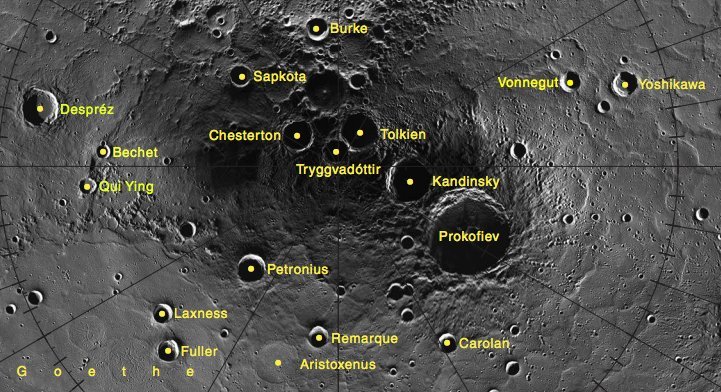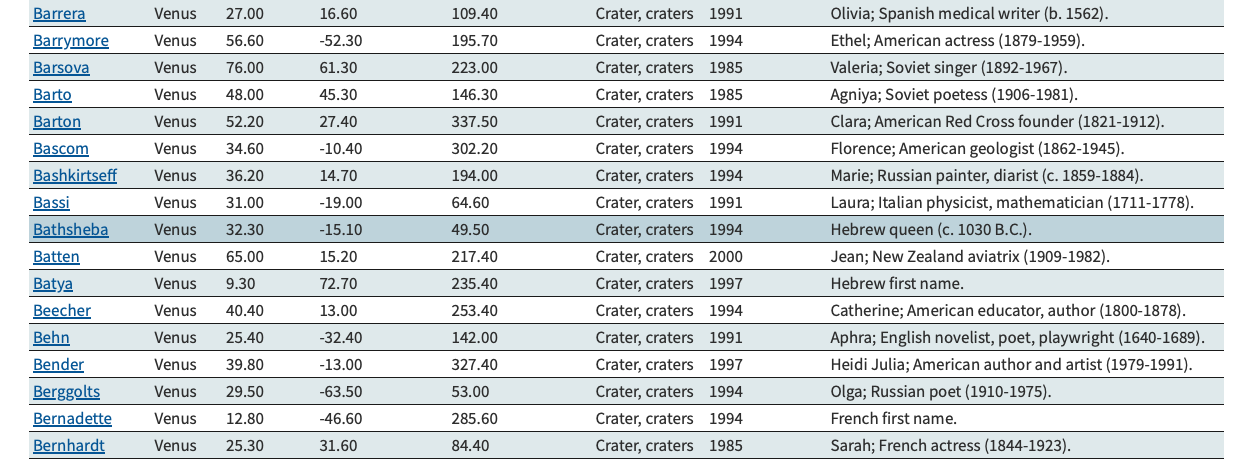Naming the Universe
THE SKY — TONIGHT — On the starriest of starry nights, the universe can be forbidding. All those stars, twinkling, pulsing. Billions and billions. . .
In Shakespeare, Romeo called them “night’s candles.” Byron waxed eloquent: “Ye stars! which are the poetry of heaven.” We wish upon them, consider some of them lucky, stand in awe. But few of us know the names of more than a few stars.
Let’s see. . . There’s Sirius, the Dog Star. And Polaris, the North Star. Betelgeuse and. . . Um. . . And these are just the stars. What about all those nebulae, galaxies, and comets? Who names them all? And how did certain craters on certain planets get named for Maya Angelou, Dr. Seuss, John Lennon. . . ?
From its base in Paris, the International Astronomical Union deals mostly in dry details. Committees and “working groups.” Conferences and catalogs. But when tasked with naming the universe, the IAU waxes more poetic than pedantic.
Even if you’re an astronomy buff able to name Mars’ two moons (Phobos and Deimos), browsing the IAU’s catalogs of names brings surprise and delight. Though the group was founded in 1919, only in the last dozen years has it brought world culture into the naming of stars, comets, craters, and now exo-planets. The fun starts with stars.
Some 400 stars were named by ancient astronomers, mostly Greek and Arabic. Hence the names Aldebaran and Altair, and the constellations — Taurus and Perseus and Cassiopeia. To these basics, the IAU Working Group on Star Names added a few dozen names, including faint stars now named Franz and Natasha. But thanks to powerful telescopes the ancients couldn’t have imagined, IAU star namers can’t hold a candle to the agency’s Working Group on Planetary Nomenclature.
Every crater, every mountain range, every ridge of a certain size seems to demand a name. The IAU is happy to oblige. Members assigned to each planet suggest names that meet specific criteria: no trademarked names, nothing named for a living person, nothing political, military or religious. And please, no names of pets.
So let’s browse an IAU catalog, starting closest to the sun.
Mercury (above) is the planet of the arts and sciences. Here we find craters named for Bach and Brahms, George Ballanchine, Brueghel, Charlotte Bronte. . . And that’s just the B’s. John Lennon got his own Mercury crater in 2013. Ursula LeGuin just got hers last November. On Mercury you can find craters named Mozart and Toni Morrison, Michelangelo and Monk (Thelonious). But it’s too hot to linger here. Next stop — Venus.
As the only planet named for a goddess, Venus features the feminine. Hundreds of craters boast common girls’ names — Karen, Elena, Vera — and dozens are named for famous women. Sarah Bernhardt, Anne Boleyn, Clara Barton (those B’s again). Patsy Cline, Anne Frank, Frida Kahlo, Maria Montessori. . .
Moving on, you know the names on Earth, and you might even know that most lunar craters are named for scientists, philosophers, and astronauts — Einstein, Plato, Sally Ride. But what about Mars?
The red planet boasts still more scientists’ names but curiously, many Martian features are named for towns — two in California (Azusa and Badwater), others in France, Colorado, and Montana. Mars also boasts craters named for two writers whose imaginations took us to Mars, Ray Bradbury and Edgar Rice Burroughs.
And on it goes through the Solar System. Jupiter, Saturn, Uranus. . . The list can be exhausting but thanks to exo-planets, it will never be exhaustive.
Exo-planets, first discovered in 1995, are planets that orbit distant stars. We can speculate endlessly about life on such remote worlds, but first, why not name them? In 2015, the IAU kicked off its NameExoWorlds project by sending 45 possible names — of both exo-planets and their respective “suns” — to its members worldwide. Suggestions came in from around this planet. May I have the envelope, please?
The results were a little boring. Spanish astronomers approved four names from Don Quixote, but most were from the usual list of scientists, gods, and goddesses. So when it came time to name more exo-planets, the IAU became more democratic.
In 2019, NameExoWorlds offered each of the IAU’s 112 member countries the chance to name one exo-planet pair. Teams of astronomers met around the world. And the winners?
Colombia named an exo-planet Melquiades, a character from One Hundred Years of Solitude. Iraq chose Babylonia. The Netherlands got Nachtwacht, the Dutch name of Rembrandt’s most famous painting. Lebanon chose its capital, Beirut. And there were exo-planets named for mountains and rivers and poets and mythological beasts, all out there. . . Somewhere.
But when it comes to nameless bodies of cosmic stuff, the universe just won’t quit. By 2022, with some 5,000 exo-planets detected, the IAU held yet another naming contest. This time, the contest was open to any team of enthusiasts from any country. Some 90 teams competed to name 20 new exo-pairs. Reflecting the cultural climate here on earth, indigenous names were encouraged.
Much of the world helped with the naming. From online lectures to week-long conventions, nearly 12 million people were involved. School kids, astronomers, native peoples, and amateur star buffs offered ideas. More than 600 official entries were filed. The winners?
Somewhere right now, in a galaxy far far away, there are exo-planets named Awohalie, Cherokee for “eagle,” and Puli, a Hungarian white dog. Someday we may receive contact from the exo-planet Kua’kua, “butterfly” in the Costa Rican tribal Bribri language. Then there are exo-names from a Croatian fairy tale, a river in Cameroon, a Korean word for “reminiscent of the ocean,” the Greek mythological keeper of the winds. . .
“The thoughtful names for these recently discovered planets and their stars, show that IAU public naming campaigns can draw upon the imagination of people around the world,” campaign chair Eric Mamajek told Astronomy.
So step outside tonight and look to the sky. The universe remains vast, infinite, forbidding. Billions and billions. But thanks to the International Astronomical Union, you now know some of the names. You belong here.












